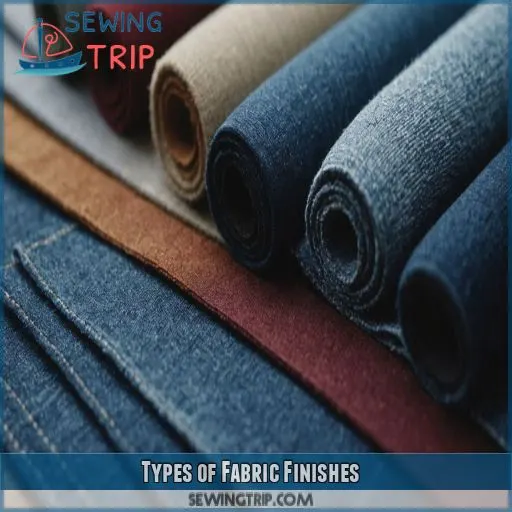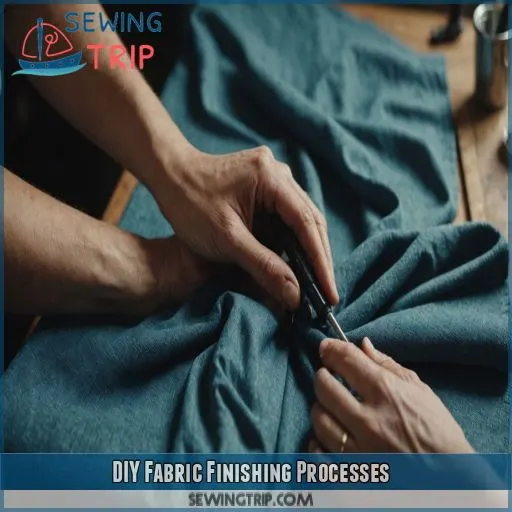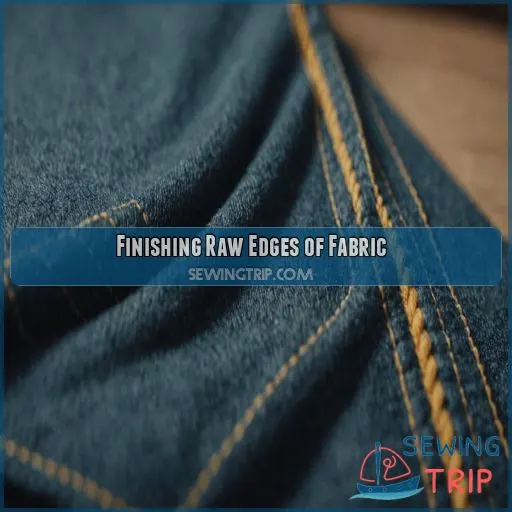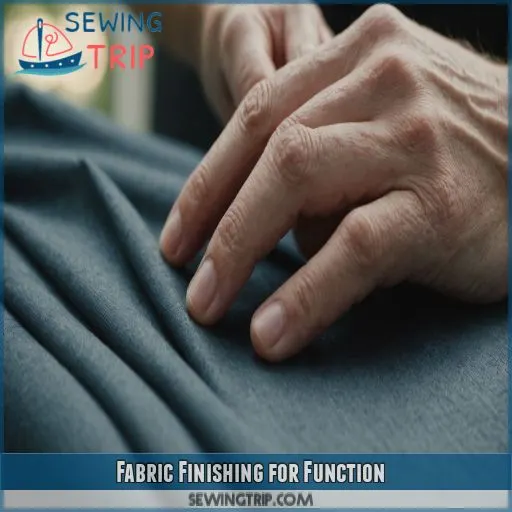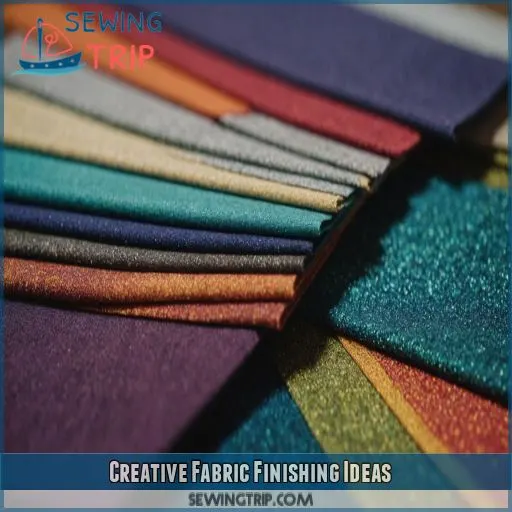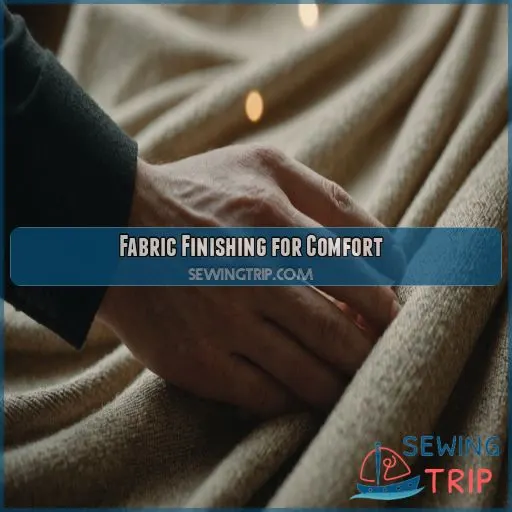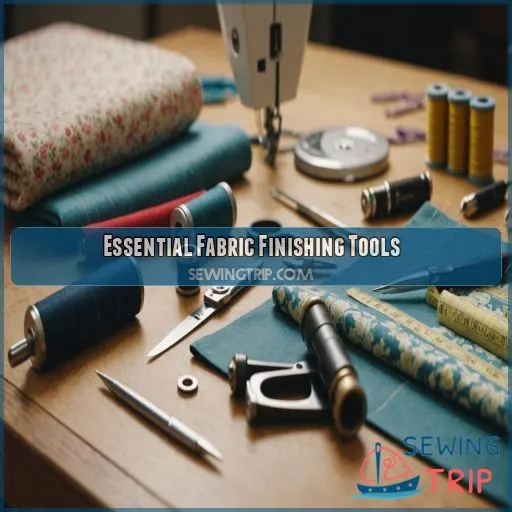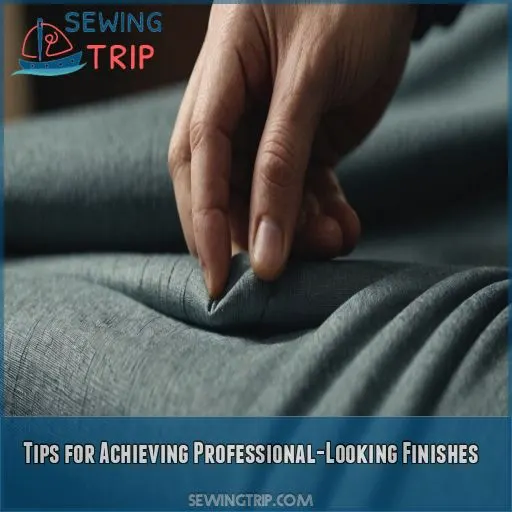This site is supported by our readers. We may earn a commission, at no cost to you, if you purchase through links.

You can achieve professional-looking results without breaking the bank or investing in fancy equipment.
With a few simple tools and some know-how, you’ll be smoothing, softening, and sealing your way to stunning fabrics in no time.
Try heat-setting, calendering, or using no-sew methods like fusible web or fabric glue to give your textiles a polished finish.
And don’t worry about raw edges – a little fray check or pinking shears can work magic!
Your fabrics are about to get a whole lot more fabulous.
Table Of Contents
- Key Takeaways
- Fabric Finishing Techniques at Home
- Types of Fabric Finishes
- DIY Fabric Finishing Processes
- Finishing Raw Edges of Fabric
- Fabric Finishing for Function
- Creative Fabric Finishing Ideas
- Fabric Finishing for Comfort
- Essential Fabric Finishing Tools
- Tips for Achieving Professional-Looking Finishes
- Frequently Asked Questions (FAQs)
- Conclusion
Key Takeaways
- Finishing techniques are the magic that turns a piece of fabric into a showstopper – think of them as the icing on the cake or the secret sauce that makes a garment go from bland to grand!
- With a few simple tools and some know-how, you can achieve professional-looking results at home, from heat-setting to no-sew methods, and totally transform your textiles.
- Don’t worry about those pesky raw edges – a little fray check, some fabric glue, or a fiery hot iron can work magic and leave you with a seamless finish (well, almost seamless – we’re not perfect).
- The possibilities are endless, from standard finishes that boost durability to decorative finishes that add a touch of elegance, so don’t be afraid to experiment and get creative – after all, practice makes perfect!
Fabric Finishing Techniques at Home
You’re just a few steps away from transforming your textiles into stunning, professional-looking fabrics that will make all your DIY projects shine!
With the right fabric finishing techniques at home, you can give your materials a polished look.
You can also boost their durability, and even add special properties like water repellency or flame resistance.
All of this is possible without breaking the bank or relying on fancy equipment.
Mechanical Finishing Methods
You’re about to get hands-on with mechanical finishing methods! These techniques manipulate fibers to enhance texture, appearance, and performance. Try these at-home methods:
- Calendering: Use heat to smooth out wrinkles and add shine to your fabrics.
- Singeing: Give your fabrics a quick burst of heat to remove excess fibers and prevent fraying.
- Napping: Brush your fabrics to create a soft, velvety texture.
Chemical Finishing Methods
| Method | Description | Benefits |
|---|---|---|
| Fabric Bleaching | Whitens or lightens fabric | Brightens colors, removes impurities |
| Chemical Softening | Treats fibers for softness | Wrinkle-resistant, comfy fabrics |
| Acid Dyeing | Colors fabrics with acid-based dyes | Rich, vibrant hues on silk, wool, and nylon |
| Enzyme Finishing | Treats fabrics with enzymes | Softens, wrinkle-resists, and eco-friendly |
These chemical finishing methods will make your fabrics look and feel professional!
No-Sew Fabric Finishing
Now that you’ve got the hang of chemical finishing, let’s switch gears to no-sew fabric finishing. Who needs a needle and thread, anyway? With fabric stabilization methods and no-sew hemming techniques, you can create a seamless finish. Try using heat-activated adhesives, DIY fabric binding, and no-sew fabric finishes like fusible web and Heat Setting for a flawless finish.
Types of Fabric Finishes
You’re about to discover the amazing world of fabric finishes, where you can transform your textiles to meet specific needs or desires. From standard finishes that boost durability to decorative finishes that add a touch of elegance, you’ll learn about the various types of fabric finishes that can take your creations to the next level.
Standard Finishes
You want to give your fabrics a solid foundation, right? Standard finishes are the way to go! These include antiwrinkle finishes, textile softening, fabric strengthening, stain resistance, and color enhancers. Techniques like mercerization, mechanical finishing, and coating can help you achieve these essential finishes. Let’s start building from the basics!
Decorative Finishes
Now that you’ve got the basics covered, let’s get creative with decorative finishes! These embellishment techniques will elevate your textiles from meh to mesmerizing. Here are a few favorites:
- Add some personality with fabric paint or markers
- Create intricate designs with fabric etching or textile printing
- Give your fabric some extra sparkle with glitter finishes
- Achieve an otherworldly sheen with iridescent effects
Advanced Finishes
Ready to take your fabric finishing game to the next level? Advanced finishes are all about innovation and high-tech benefits. Think nano finishes, fragrance finishes, thermochromic finishes, conductive finishes, and biomimetic finishes that combine style with function, like anti-microbial and UV-resistant properties. The possibilities are endless!
Custom Finishes
Now that you know about advanced finishes, let’s get personal with custom finishes. With custom application-driven designed textiles, you can adapt your fabric to specific needs. Here are some specialty finishing techniques worth exploring:
- Fabric solutions for unique applications
- Custom finish applications for specialty textiles
- Specialty finish designs for one-of-a-kind fabrics
- Personalized textile finishes using fabric glue or other materials.
DIY Fabric Finishing Processes
You’re about to discover the secret to transforming your textiles from ordinary to extraordinary. With DIY fabric finishing processes, you’ll learn how to apply professional-looking finishes to your fabric projects from the comfort of your own home, using simple techniques like washing and drying, heat setting, calendering, and dyeing.
Washing and Drying
Now that you know about the various fabric finishes, let’s talk about washing and drying – the simplest DIY fabric finishing process. Be mindful of spin cycle options, fabric shrinkage control, and delicate wash methods to prevent damage. Hand washing techniques and proper drying temperature settings can make all the difference.
Heat Setting
Let’s get heat-setting! You can use a home iron or a heat press to fix fabric textures and prevent shrinkage. Temperature control is key – each fabric type has its sweet spot. Invest in a thermometer and a pressing cloth to master this thermal finishing technique.
Calendering
Get ready to give your fabrics a spa day with Calendering! Using calendering machines or a simple heat pressing technique, you can smooth out wrinkles, enhance texture, and prevent stretching. This process is a game-changer for greige fabric, providing comfort and a polished look.
Dyeing
You’re ready to express your creativity with dyeing! Explore natural dye techniques, try out fabric dye recipes, and master hand dye methods. Understand dye color theory to achieve unique shades. Don’t be afraid to experiment with indigo dye process, and combine it with fabric shearing for a one-of-a-kind look.
Finishing Raw Edges of Fabric
When working with fabrics, you’ll inevitably encounter raw edges that can fray and compromise the entire project – but don’t worry, there are ways to tame those unruly edges without losing your mind. By mastering the art of finishing raw edges, you’ll be able to create professional-looking garments and home decor items that will make you proud .
No-Sew Methods
The no-sew method – a game-changer for those who dread threading their sewing machine! You can finish raw edges with fusible interfacing, heat sealing, or adhesive options like fabric glue or iron-on tapes. These no-sew bindings are perfect for a quick fix or a beginner’s project. With a little practice, you’ll be a pro at no-sew finishing in no time!
Raw Edge Techniques
Dealing with raw edges, you’ve got a few tricks up your sleeve to keep them from fraying. Here are three techniques to try:
- Fray Check and fabric glue: Apply a small amount to prevent fraying, but don’t overdo it, or you’ll end up with stiff fabric.
- Pinking shears: Cut a zigzag edge to reduce fraying and add a decorative touch.
- Heat-sealing: Use a hot iron to seal synthetic fabrics and prevent erosion.
Benefits of Finishing Raw Edges
Finishing raw edges is a game-changer! By securing those pesky loose threads, you’ll prevent fraying, reduce wear and tear, and reinforce your seams. Say goodbye to fray-prone edges and hello to professional-looking projects. Edge stabilization is key to creating durable, long-lasting textiles. So, take the extra step and finish those raw edges – your creations will thank you!
Fabric Finishing for Function
You can give your fabrics a functional boost with techniques like flame retardant, water repellent, and UV resistant finishing.
These aren’t just for factories, you can achieve them at home with a little know-how!
By applying these finishes, you’ll also protect your fabrics and make them more durable and long-lasting.
This is perfect for projects that’ll be exposed to the elements or heavy use, while also providing added benefits.
Flame Retardant Finishing
You’re on a mission to create flame retardant fabrics that meet the highest safety standards. Flame retardant finishing is an essential process that reduces fabric flammability, providing peace of mind and protection from fire hazards. Here’s what you need to know:
- Flame retardant chemicals can be applied to fabrics to meet textile safety standards.
- Fabric burning tests assess the effectiveness of fire resistant treatments.
- Heat resistant materials can be used to create flame retardant fabrics that pass the tests.
Water Repellent Finishing
You want to keep your fabrics dry and comfortable, right? Water repellent finishing is the way to go. This technique treats fabrics with hydrophobic coatings, making them resistant to water and stains. Here are some common textile waterproofing techniques:
| Water Repellent Coatings | Benefits |
|---|---|
| Silicone finishes | Durable, soft feel |
| Paraffin wax coatings | Cost-effective, quick application |
| Polyurethane treatments | Breathable, easy care |
| Nanotech coatings | Ultrathin, eco-friendly |
| Fluorochemical finishes | Long-lasting, no stiffening |
UV Resistant Finishing
Now that you’ve mastered water repellent finishing, let’s talk UV resistant finishing! This technique is like applying sunscreen to your fabric, protecting it from harsh UV radiation. Using specialized treatments or finishes, you can create radiation-resistant textiles perfect for outdoor gear or clothing. Effective UV finish methods include applying solar shielding techniques to fabrics, resulting in long-lasting protective clothing finishes.
Creative Fabric Finishing Ideas
Now that you’ve mastered the basics of fabric finishing, it’s time to get creative and add some personality to your textiles. With a few simple techniques, you can turn your fabrics into one-of-a-kind masterpieces that reflect your unique style and flair.
Fabric Paint and Markers
Now that you’ve mastered fabric finishing for function, let’s get creative with fabric paint and markers. You can discover a world of custom design ideas and bring your unique vision to life. Here are some inspiring tips to get you started:
- Experiment with color mixing techniques to create one-of-a-kind hues
- Try popular fabric marker brands like Tulip or Sharpie
- Get inspired by painted fabric projects on Pinterest or YouTube
- Choose permanent ink options for a durable, long-lasting finish
Decorative Trims and Ribbons
Let’s get fancy with decorative trims and ribbons! Adding a touch of elegance to your fabric is easier than you think. Try pairing ribbons with contrasting fabrics or using them as a pop of color.
| Ribbon Trim Ideas | Decorative Edge Techniques | Trim Attachment Methods |
|---|---|---|
| Satin ribbon | Folding and tucking | Hot glue gun |
| Lace trim | Gathering and ruffling | Sewing |
| Ribbon embellishments | Binding and wrapping | Fusible webbing |
| Appliqué designs | Fringing and tasseling | Safety pins |
| Beaded trim | Quilting and stitching | Fabric adhesive |
Embroidery and Cross-Stitch
Get creative with embroidery and cross-stitch! Choose from various embroidery floss types, like cotton or silk, and select cross-stitch patterns that fit your style. Pick the right embroidery needle and hoop for your project. As a beginner, start with simple cross-stitch patterns and gradually move to intricate designs. Don’t be afraid to experiment – it’s all part of the fun!
Fabric Finishing for Comfort
You’re about to discover the secret to making your fabrics feel amazing against your skin – it’s all about the finishing techniques that prioritize comfort! By exploring softening fabric finishes, anti-static finishes, and anti-microbial finishes, you’ll learn how to transform your textiles into haven-like materials that cradle you in comfort and tranquility.
Softening Fabric Finishes
Now that we’ve explored some creative fabric finishing ideas, let’s get cozy with softening fabric finishes. Who doesn’t love wrapping themselves in plush, gentle fabrics? To achieve this bliss, you can try:
- Using natural softening methods like washing with vinegar or baking soda
- Adding fabric softener sheets to your dryer
- Brushing your fabrics with a soft-bristled brush
- Trying DIY softening recipes with ingredients like coconut oil or shea butter
- Investing in fabric softening tools like a fabric steamer or a de-piller
Anti-Static Finishes
The dreaded static cling! Don’t let it ruin your favorite fabrics. Anti-static finishes are here to save the day! These fabric treatments reduce static electricity, making your textiles feel softer and less clingy. Apply static resistant coatings or use anti-cling treatments to enjoy a more comfortable fabric experience. Say goodbye to frizzy clothing and hello to a static-free life!
Anti-Microbial Finishes
You want to keep your fabrics fresh and germ-free. That’s where anti-microbial finishes come in. These treatments prevent the growth of bacteria, odor, and mildew on your textiles. Here are four ways to achieve this:
- Silver Treatments: Infuse your fabrics with silver ions to combat microbes.
- Copper Infusion: Copper’s natural anti-microbial properties will keep your fabrics clean.
- Microban Technology: This tech prevents microbial growth on fabrics.
- Bio-based Coatings: Use plant-based coatings to create a germ-free fabric surface.
Essential Fabric Finishing Tools
As you explore the realm of fabric finishing, you’ll discover that having the right tools at your fingertips can make all the difference in achieving professional-looking results. With essential fabric finishing tools like fabric glue, fusible webbing, and heat-activated hem tape, you’ll be able to give your textiles a polished finish that’s both functional and visually appealing.
Fabric Glue
Now that we’ve talked about fabric finishing, let’s move on to fabric glue—a game-changer.
When choosing a fabric glue, consider these factors:
- Shelf life
- Potential alternatives, like fabric adhesive tape
Keep fabric glue removers handy in case you need to remove the glue.
Mastering glue application techniques, like applying thin, even coats, will ensure a strong, long-lasting bond.
Fusible Webbing
You’re about to become a pro at fusible webbing! This heat-activated adhesive wonder helps you attach fabrics without sewing. Use it for appliques, patches, or even creating unique designs. Choose from various types, like cotton or knit-specific webbing. Apply it to your fabric, and with a quick press of the iron, you’ll have a professional-looking finish in no time.
Heat-Activated Hem Tape
Now that you’ve mastered fusible webbing, it’s time to tackle heat-activated hem tape! This game-changing tool produces a crisp, professional finish. To get the most out of it:
- Prep your fabric: Wash and dry before applying tape.
- Choose the right tape: Select a suitable adhesive strength and fabric compatibility.
- Apply carefully: Smooth out wrinkles and air bubbles.
- Heat wisely: Use the right temperature and time for activation to guarantee a perfect bond.
Tips for Achieving Professional-Looking Finishes
You’re just a step away from taking your textiles to the next level.
Master a few simple techniques and you’re on your way:
- Choose the right fabric finish.
- Follow instructions to a tee.
- Practice, practice, practice.
Nail these and you’ll be giving your DIY projects that sleek, polished look, making them indistinguishable from the work of pros.
Choosing the Right Fabric Finish
When choosing a fabric finish, consider the weight, blend, and desired texture.
Think about the purpose of the item and the season it will be used in.
Do you need durability or soft, cozy fabric?
Don’t be afraid to experiment. Your finished project will benefit from it.
Following Fabric Finishing Instructions
Alright, you’ve chosen the perfect fabric finish! Now, listen up:
- Carefully follow the instructions.
- Measure precisely.
- Don’t skip safety precautions—those chemicals can be feisty!
Understand the finish’s limitations and troubleshoot common errors.
Consistency is key:
- Take your time.
- Work methodically.
Your patience will be rewarded with professional-looking results that will make you proud!
Practicing Fabric Finishing Techniques
Practice makes perfect. Start with scrap fabric to test and hone your fabric-finishing skills.
You’ll soon develop an eye for the best finishes and tools for each project.
Don’t stress if it’s not perfect the first time – even professionals encounter hurdles.
Troubleshoot and adjust, and you’ll quickly achieve those sought-after, professional-looking finishes.
Frequently Asked Questions (FAQs)
How do you finish a fabric?
Finishing a fabric is like putting the icing on a cake – it’s the final touch that makes all the difference. You can wash, dry, heat-set, calender, dye, or coat your fabric to give it the desired look and feel.
How do fabric finishes work?
You’re probably wondering, how do fabric finishes work? Well, they’re like a special sauce that enhances your fabric’s performance, durability, and appearance by altering its texture, color, and utility through various chemical or mechanical treatments.
What are textile finishing techniques?
You’re a master weaver, enthusiastic to transform your fabric. Textile finishing techniques are your magic wand – calendering for smooth finishes, bleaching for vibrant colors, and mercerizing for super-strong cotton.
What is fabric finishing & treatments?
You’re about to discover the secret to transforming your fabrics. Fabric finishing and treatments modify a fabric’s performance, durability, or aesthetic, enhancing its utility, texture, and color through dry or wet processes, and that’s what we call fabric magic!
What are the 4 types of fabric finishing?
Get ready to give your fabrics a spa day! You’ve got four fantastic finishing options: Standard finishes for practicality, Decorative finishes for a style boost, Advanced finishes for wellness benefits, and Custom finishes for a personalized finish.
How do you make fabric glossy and smooth?
You can make fabric glossy and smooth by using calendering, which involves heating and pressing the fabric with rollers . Alternatively, try using a fabric spray or glaze finish, and gently ironing the fabric to achieve a smooth finish .
What is one way of treating a fabric into a special finish?
You can treat a fabric to a special finish by calendering, where you use heated rollers to smooth and compress the fibers, giving it a glossy appearance – pretty cool, right?
What are the three fabric finishes?
Finishing techniques are like the icing on a cake – they elevate the fabric to the next level. You can achieve three main types of fabric finishes: standard finishes, decorative finishes, and advanced finishes.
What are common fabric finishes used in textile production?
You’re just a step away from creating awesome fabrics! Common fabric finishes include anti-microbial, anti-static, UV-resistant, fire retardant, and chemical-resistant treatments that boost performance and durability – explore these to elevate your textile production! .
Can custom fabric finishes be designed for specific applications?
You can design custom fabric finishes for specific applications by working with engineers and product designers to craft textiles that meet your customer’s specifications, ensuring products pass testing and meet end goals .
What are the benefits of using mechanical finishing techniques?
By using mechanical finishing techniques, you’ll get smoother, shinier fabrics with a more textured feel. You’ll enhance the look and feel of your fabrics without changing their composition, making them more visually appealing and comfortable to use.
How does chemical finishing enhance fabric properties and traits?
You can enhance fabric properties and traits through chemical finishing, which treats fabrics with chemicals to modify properties like softness, color, and durability, altering content without visual changes, and resulting in improved performance and appearance .
What are some creative edge ideas for fabric finishing?
Don’t think you’re limited to plain hems! Get creative with your fabric finishing edges by using fabric paint, decorative trims, embroidery, lace trim, or even unique dyes to add a personal touch and elevate your projects.
Conclusion
Imagine transforming your textiles from bland to grand with just a few simple techniques.
You’ve now got the inside scoop on fabric finishing techniques at home, from heat-setting to no-sew methods.
With practice, you’ll be smoothing, softening, and sealing your way to stunning fabrics in no time.

